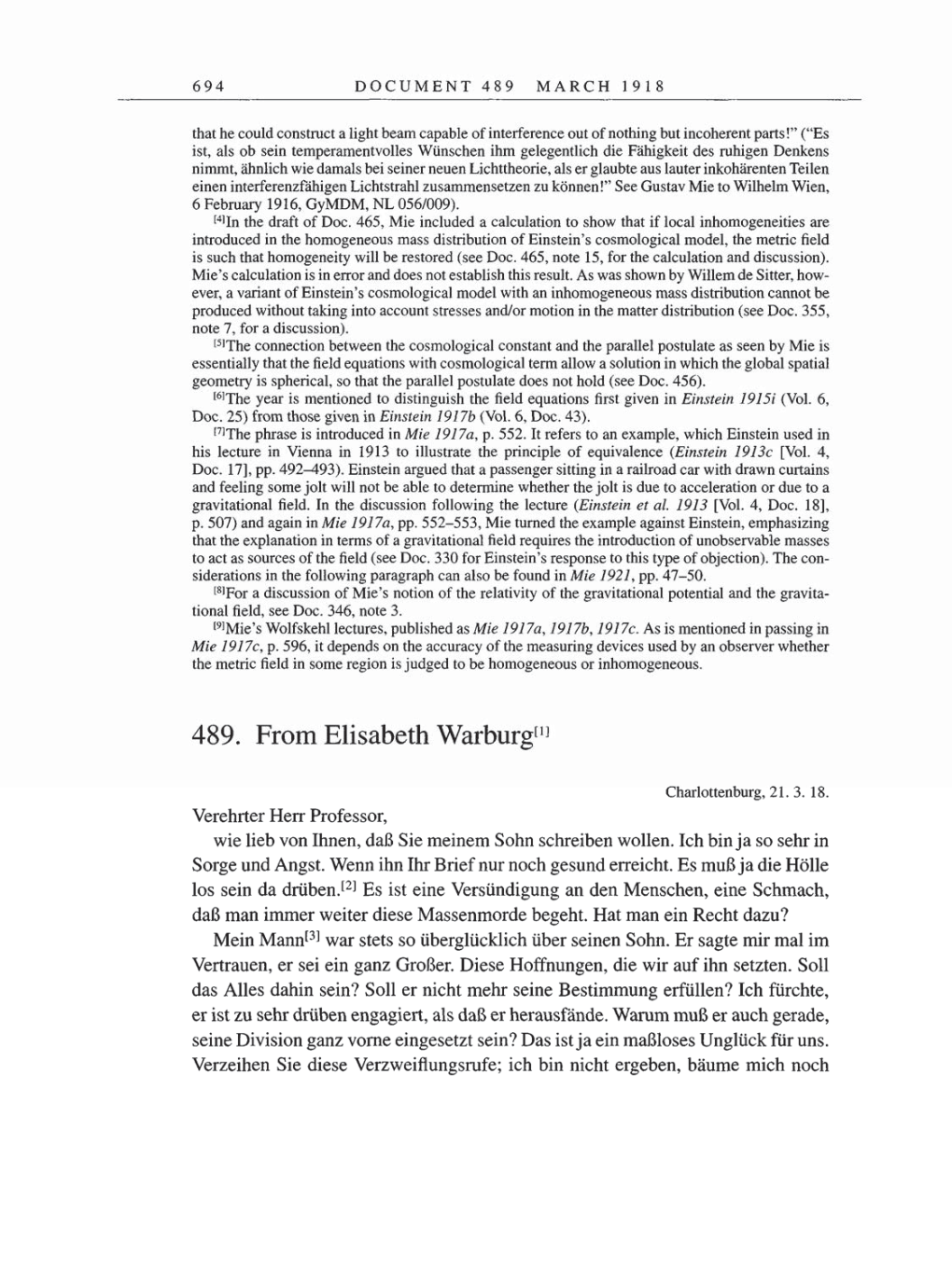694
DOCUMENT 489
MARCH
1918
that he could
construct
a light
beam
capable
of
interference
out
of
nothing
but incoherent
parts!" ("Es
ist,
als ob sein
temperamentvolles
Wünschen ihm
gelegentlich
die
Fähigkeit
des
ruhigen
Denkens
nimmt,
ähnlich wie damals bei seiner
neuen
Lichttheorie,
als
er glaubte aus
lauter inkohärenten Teilen
einen
interferenzfähigen
Lichtstrahl zusammensetzen
zu
können!" See Gustav Mie
to
Wilhelm
Wien,
6
February
1916,
GyMDM,
NL
056/009).
[4]In
the draft
of
Doc.
465,
Mie included
a
calculation
to
show that
if
local
inhomogeneities are
introduced in the
homogeneous mass
distribution
of
Einstein’s
cosmological
model,
the metric field
is such that
homogeneity
will be restored
(see
Doc.
465, note
15,
for the calculation and
discussion).
Mie’s calculation is in
error
and does
not
establish this result. As
was
shown
by
Willem de
Sitter,
how-
ever,
a
variant
of
Einstein’s
cosmological
model with
an inhomogeneous mass
distribution
cannot
be
produced without
taking
into
account stresses
and/or motion in the matter distribution
(see
Doc.
355,
note
7,
for
a discussion).
[5]The
connection between the
cosmological
constant and the
parallel postulate as seen by
Mie is
essentially
that the field
equations
with
cosmological
term allow
a
solution in which
the
global spatial
geometry
is
spherical, so
that the
parallel postulate
does
not
hold
(see
Doc.
456).
[6]The
year
is mentioned
to
distinguish
the field
equations
first
given
in
Einstein
1915i
(Vol. 6,
Doc.
25)
from
those
given
in
Einstein
1917b
(Vol.
6, Doc.
43).
[7]The phrase
is
introduced
in Mie
1917a,
p.
552. It
refers to
an
example,
which Einstein used in
his lecture in Vienna in
1913 to
illustrate the
principle
of
equivalence (Einstein
1913c
[Vol.
4,
Doc.
17], pp.
492-493). Einstein
argued
that
a
passenger
sitting
in
a
railroad
car
with drawn curtains
and
feeling some
jolt will not
be able
to
determine whether the
jolt
is due to acceleration
or
due
to
a
gravitational
field.
In
the discussion
following
the
lecture
(Einstein et
al. 1913
[Vol.
4,
Doc.
18],
p.
507)
and
again
in Mie
1917a, pp.
552-553, Mie turned the
example
against
Einstein,
emphasizing
that the
explanation
in
terms
of
a gravitational
field
requires
the introduction
of
unobservable
masses
to act
as sources
of
the field
(see
Doc. 330 for Einstein’s
response
to this
type
of
objection).
The
con-
siderations in the
following paragraph
can
also be found in Mie
1921, pp.
47-50.
[8]For a
discussion
of
Mie’s
notion of
the
relativity
of
the
gravitational potential
and the
gravita-
tional
field, see
Doc.
346,
note 3.
[9]Mie’s
Wolfskehl
lectures, published
as
Mie
1917a, 1917b,
1917c. As is mentioned in
passing
in
Mie
1917c,
p.
596,
it
depends on
the
accuracy
of
the
measuring
devices used
by an
observer
whether
the metric field
in
some region
is
judged
to
be
homogeneous
or inhomogeneous.
489. From Elisabeth
Warburg[1]
Charlottenburg,
21.
3.
18.
Verehrter
Herr
Professor,
wie lieb
von
Ihnen,
daß
Sie
meinem
Sohn
schreiben wollen. Ich bin
ja
so
sehr in
Sorge
und
Angst.
Wenn ihn Ihr
Brief
nur
noch
gesund
erreicht. Es muß
ja
die Hölle
los
sein
da
drüben.[2]
Es ist eine
Versündigung an
den
Menschen,
eine
Schmach,
daß
man
immer
weiter diese Massenmorde
begeht.
Hat
man
ein Recht dazu?
Mein
Mann[3]
war
stets
so überglücklich
über
seinen Sohn. Er
sagte
mir mal im
Vertrauen,
er
sei ein
ganz
Großer. Diese
Hoffnungen,
die wir
auf
ihn
setzten.
Soll
das Alles dahin sein? Soll
er
nicht
mehr seine
Bestimmung
erfüllen? Ich
fürchte,
er
ist
zu
sehr drüben
engagiert,
als daß
er
herausfände.
Warum
muß
er
auch
gerade,
seine Division
ganz vorne eingesetzt
sein? Das ist
ja
ein maßloses
Unglück
für
uns.
Verzeihen
Sie
diese
Verzweiflungsrufe;
ich
bin nicht
ergeben,
bäume mich noch
